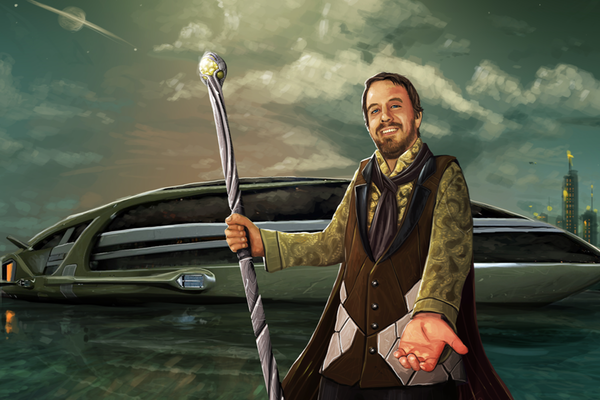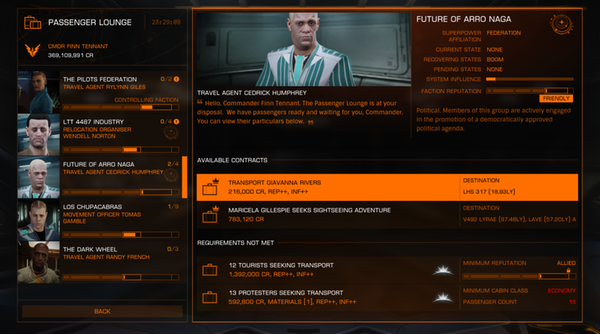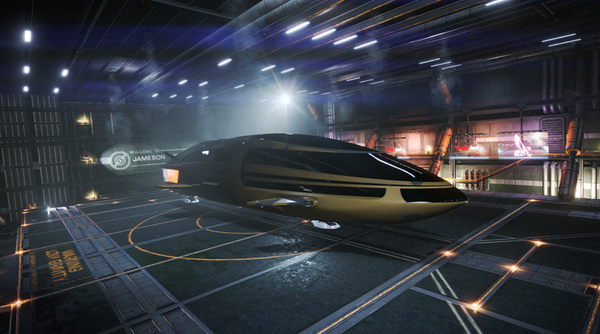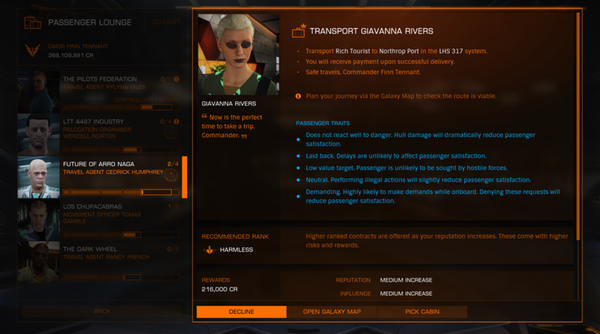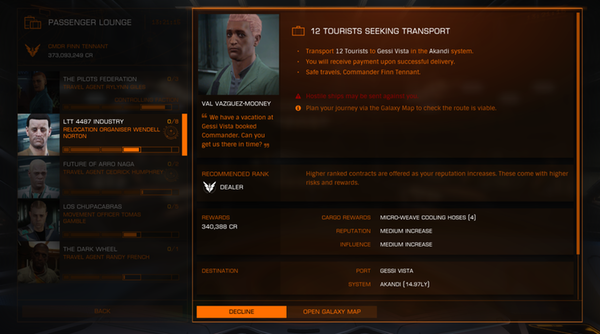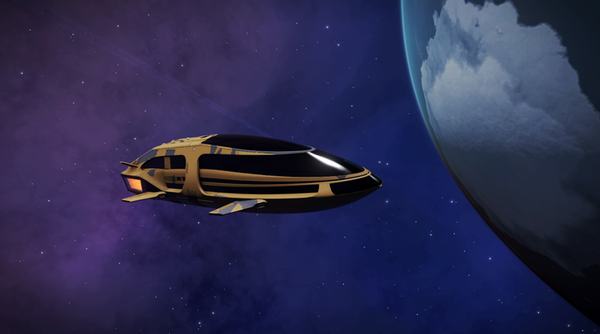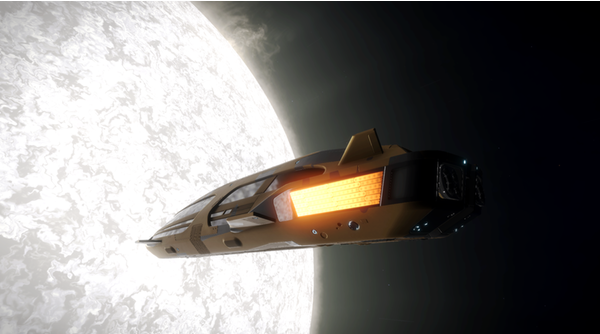We have clearance, Clarence. Roger, Roger. What’s our vector, Victor?
– Cockpit crew in the movie Airplane
In the event of a sudden loss of cabin pressure margarine cups will descend from the ceiling. Stop screaming, grab the mask, and pull it over your face. If you have a small child traveling with you, secure your mask before assisting with theirs. If you are traveling with more than one small child, then pick your favorite.
– Anonymous Flight Attendant
Do you dream of babysitting demanding celebrities, covering for criminals on holiday, acting as a guide for nervous Explorers, and generally being an interstellar Uber driver? Then the job of Liner Pilot in Elite: Dangerous is for you! Oh, the sights you’ll see, and the snotty noses you’ll wipe.
Seriously, it’s not all that bad and it is actually a fantastic way to dip your toes into Exploration, while running missions and gaining reputation with local and galactic factions. The pay is also pretty decent, once you gain a reputation for providing safe, efficient, and discrete travel services to the residents of The Bubble.
The Job
Everything the Liner Pilot does centers around the Passenger Lounge located in Starport Services on most stations. In the Passenger Lounge, pilots will find a host of passengers looking to book trips near and far (and I mean far … I’ve seen some that want to travel 50,000ly, round trip). Celebrities, politicians, scientists, rebels, refugees, just plain tourists, and more all have places to be. Some require only the most basic accommodations and won’t make a peep the whole trip, while others need veritable palaces aboard any passenger liners they would even consider, and will be making demands for course changes and beer runs (so not joking) even before the first port of call is reached.
The Liner Pilot’s job is to carefully weigh the passenger contracts available, their needs, special requirements, travel distance, time frame, etc., against the amenities aboard their ship, the ship’s range, and passenger capacity. The goal is to get as many butts in as many seats as possible before launching on the first leg of any particular run. Much like Traders with their cargo capacity, Liner Pilots should always try to fill up all available bunks, cabins, and suites before takeoff.
Once the Liner Pilot has a full passenger list, the rest of the job is fairly straight forward: ferry the passengers to their respective destinations while keeping a weather eye on the comms for any request they may have en route.
The Ship
While the best and most interesting fares will be available to pilots of luxury passenger liners like the Beluga and the Orca, because these ships can fit the size 5, Luxury class cabins some of the higher paying VIPs require, any ship with at least one spare size 2 compartment can fit an Economy class cabin to haul passengers around in; Business class requires a size 3 compartment, and First class requires a size 4 compartment.
Beyond the ability to fit cabins, all the usual considerations for range, speed, and safety should be made when outfitting the rest of the ship. Many passengers only need to go short distances, within The Bubble, but others will want to travel great distances, making several stops, where jump range and fuel become important. Some passengers will have security concerns, so a ship’s ability to outrun unwanted visitors and stay safe while Frame Shift Drives spool up is also worth some though.
Finally, most passenger missions reward Materials and/or Commodities, in addition to the fares, so some cargo capacity is desirable, especially when one of the passengers suddenly needs 4 tons of grain. And, since many passengers will have Liner Pilots traveling to areas of the galaxy they may not have visited before, a Discovery Scanner will come in very handy, eliminate the need for dropping in on Nav Beacons, and quickly pay for itself and any operating costs in exploration data.
Over all, the well outfitted passenger ship should be fast, safe, have plenty of space for passengers, their entourages, and luggage, and have enough bells and whistles to keep everyone, pilot included, happy.
Doing the Work …
The job of the Liner Pilot combines the skills of the Trader, the Smuggler, and the Explorer, with a touch of the Bounty Hunter. A successful Liner Pilot has to be well versed in docking with stations efficiently, using EDDB to source Commodities, avoiding System Authority, using the Galaxy and System maps to plot courses and locate celestial bodies and objects, and, on some occasions, gunning down pests. While the lower paying fares usually just require a Liner Pilot to transport passengers from point A to point B, much like cargo, the high value tickets will often require multiple course changes, discreet flying in supercruise and normal space, the location and acquisition of Commodities to please the passengers, and sometimes eliminating hunters sent to capture their passengers. For this reason, it is very important to carefully read Passenger Contracts before accepting them.
Is the potential booking wanted by System Authority? Do they have a propensity for being demanding? Is time of the essence, and should danger be avoided, or are they laid back and possessing of nerves of steel? How far do they want to go? Is it in The Bubble, or way out in the black? The answers to all of these questions and more are in each Passenger Contracts. Carefully reading them will go a long way toward efficient and successful completion of each run.
One of the first things to consider is the distance to the port of call. This is listed in the Destination portion of the contract. While many of the distances are relatively short, 10 – 100 light years, some can be as far as 1000 – 20,000 light years. There’s nothing wrong with any particular distance, so long as you’re willing to commit to the play sessions involved in completing said missions in the time allotted; a trip of 1000ly can take several hours to complete. This brings up the second thing to consider: how much time you’re allotted to complete the mission. Most will have a time limit of 10 – 12 hours, but the longer ones can be measured in days or even weeks.
Time usually isn’t a factor if you’re doing one mission at a time, but if you’re stacking missions, to fill all available cabins, you’ll want to make sure you have time to do them all. For this reason, it’s best to stack missions of similar ranges. That is, all short range (10 – 20ly), all medium range (50 – 100ly), or all long range (500+ light years). Also consider stacking missions of similar types: all shuttle missions, or all sightseeing missions. By doing this you won’t end up in a situation where you have several medium range fares that only have a few hours left to complete, and you have to put in a marathon session to complete a long range one so you can turn them all in on time. The last thing to consider, where distance is concerned, is that most Sightseeing tours are at least double the advertised distance, because the fare will want to return to the port of origin. So, if you’ve picked up a fare that wants to go 2000ly to see some nebula, that trip is actually 4000ly because they’ll want to return to the port where you picked them up.
Passanger temperament is another thing to consider. Some are laid back and will have no qualms about getting into some action. Others will bail at the slightest hull damage. Some will only contact you to let you know they’re ready to head home, while others will want you stopping to pick them up all sorts of treats. Other passengers, still, may be wanted by authorities, or are being hunted by assassins or bounty hunters. For these passengers you’ll need to be every wary of Interdictions and Scans.
Scans can generally be avoided by dropping preemptive Chaff. Chaff won’t stop a scan in progress, but will generally prevent one from starting, giving you time to boost out of range. For Interdictions, throttle down to zero, submitting to the Interdictions, drop preemptive Chaff, and boost away until your Frame Shift Drive spools up and you can jump out. Staying in normal space only as long as necessary to do whatever the passengers want is advisable. Don’t check maps or systems in normal space; do this in supercruise between jumps. Time in normal space is time you could get scanned or attacked. Also, learn to dock with stations as quickly as possible.
Being scanned, while carrying passengers that don’t want to be, lowers their Passenger Satisfaction. The number of levels in the Passenger Satisfaction scale is unclear, as is how far they can be pushed, but I have had passengers with Passenger Satisfaction ratings of Miserable, and they didn’t make use of their escape pods. Your mileage may vary. If the passenger is wanted, and you’re scanned, it could result in a fine or even a lethal response from System Authority. Best to avoid scans all together.
For Sightseeing tours, you’re going to be taking passengers to visit Tourist Beacons throughout the galaxy. Tourist Beacons are loaded with lore and interesting bits of information about the local sights and history. When you drop out of supercruise near one, and target it, a short ship’s scan will happen and you’ll get a message in your comms. This message will contain the lore and sightseeing details to read at your leisure and should advance the mission that brought you there. If you have wanted passengers and/or have been Interdicted recently and escaped (in the same system), be on the look out of baddies. As the ship’s scan is being run, check your radar and contacts for anyone suspicious. If the coast is clear you can probably take some screen shots or read the beacon message, but if not, bug out as soon as the scan is complete. If I’ve recently been Interdicted, or suspect there might be hostiles near the Tourist Beacon, I’ll usually drop preemptive Chaff as soon as I drop in, then target the beacon for my scan. It’s also a good idea to know what your next jump is so you can select it right after the scan and High Wake out.
For very long range missions you’re going to need to familiarize yourself with navigating around the Galaxy Map. This is because the maximum distance you can plot a course is 1000ly. Some Sightseeing tours are 2000ly or more, one way, so you’ll need to know how to locate stars in between your point of origin and destination so you can plot a course of less than 1000ly, then plot another when arrive part way to your destination. Although it is a few years old, the basics of navigating the Galaxy Map demonstrated in this tutorial are still sound. Give it a watch if you’re having trouble finding way points for long range Sightseeing missions. If you don’t want to play around with the Galaxy map, there is a tool to help plot very long courses (those in excess of 1000ly). By entering your source System, destination System, single jump range (preferably the “full tank” single jump range), and how far off course you want to deviate to use boosts from Neutron Stars into the Elite Dangerous Neutron Router, it will lay out a course for you in convenient check-list form. Just plot a course to each system on the list in turn, in the Galaxy Map, and eventually you’ll get there.
It should be noted that there are two types of passengers: general and VIP. The main difference between them is that general passengers will happily share a cabin with others, meaning that you can stack multiple general passenger missions in a single cabin if there is room. VIP passengers, on the other hand, will not share cabins; even if your luxury cabin has room for eight, if that VIP you picked up only has two people in his party, or even just himself, they will take up the entire cabin. Because of this it is wise to upgrade VIPs; even if they only require Economy class, stick them in something with less capacity. You don’t want one VIP taking up your whole Economy class cabin. You can easily tell the difference in the Passenger Lounge, because VIPs have a crown next to the suitcase icon.
While almost every starport has a Passenger Lounge, some of the best, highest paying fares are available from the Passenger Lounges in star systems with a Tourism economy. You can find such systems by either using the Galaxy Map, filtering on Economy, or by using EDDB‘s Systems tool. Simply select Tourism from the Primary Economy drop-down, enter the system you’re currently in in the Reference System text box, and click Find Systems in the lower right of the form. A list, ordered by distance, will be provided. Either way, once you choose one or more hubs to do Passenger missions from, you’re going to want to raise your reputation with the local factions controlling those systems. This can be done by selling exploration data, trading, running missions, or simply doing available passenger missions with the understanding that the higher your reputation with a local faction the richer and more interesting Passenger missions will be offered.
Currently the meta game involves stacking as many general passenger missions (non-VIP) as possible (playing the mode switching game), in Wu Guinagi bound for HIP 10716, into a ship equipped with as many Economy class cabins as it can fit. Then you repeat the process in HIP 10716 with passengers bound for Wu Guinagi. This is apparently the best credit per hour route currently in the game. I don’t know how long it will last, so if you don’t mind essentially running human freight between two points, it’s a good way to make quick credits.
… With the Right Tools
Knowing where to pick up fares and the sorts of trouble you can get into with them is only half the battle. The other half is choosing and outfitting a ship that will help you mitigate some of that trouble and also help snare the highest paying passengers. As I mentioned at the beginning of the post, any ship with at least a spare size 2 compartment can be used for Passenger missions. Just to prove my point, here’s Sidewinder outfitted as a Taxi. Oh, you won’t be hauling around dignitaries, but Uber and Lyft should be so lucky to have an interstellar ride like that. With a top rated Frame Shift Drive and a Fuel Scoop it can go almost anywhere, given enough time, and the Chaff Launchers and twin gimbaled Pulse Lasers will help fend off any bad guys trying to poach your fares.
Of course, eventually you’ll want to do more than ferry a couple of Economy class passengers around, so keeping in mind the size rules for the different classes of Passenger Cabins mentioned earlier in this post, and the general rules for outfitting ships I laid out here, you should be able to outfit any ship to do whatever you like in the realm of carting around passengers. A couple of things to keep in mind: a Fuel Scoop will vastly extend your range, and you’re going to need at least one set of Cargo Racks for things passengers might want you to procure and the mission reward commodities they sometimes offer. As mentioned earlier, Chaff Launchers will help you delay scans while you run away, and hunted passengers will sometimes offer a bonus for destroying those hunting them, so Hard Points or even Ship Launched Fighters are something to consider. It should also be noted that Passengers can always be upgraded, but can never be downgraded in class of accommodations, so I often don’t bother with Economy class cabins unless I’m outfitting a ship where it’s the only option, or i’m rigging a ship for short, shuttle type runs.
Currently I’m flying this Orca for Passenger missions. It’s got all of the amenities discussed, as well as an Advanced Discovery Scanner so that I don’t have to visit Nav Beacons (less time in Normal space) and I can make extra credits on the side with exploration data. It’s not exactly a combat ship, but it’s fast, so I didn’t fit any hard points; I just cut and run when hunters come after my passengers. I’m working toward this Beluga build; it’s not really a combat ship either, but with its Ship Launched Fighters and turreted Pulse Lasers I should be able to take out anyone who comes a’knockin’. I could outfit a more combat capable ship for Passenger Missions, but I like having the option for Luxury class cabins. As of right now, only the Orca and the Beluga can outfit them.
Wrapping it up
Passenger Missions are still relatively new in Elite: Dangerous and I’ve only had a couple of weeks to play around with them. Still, I hope I’ve been able to provide you with enough information to get you started. Right now, r/EliteTraders seems to be the place for discussing all things Liner Pilot related. Definitely check it out if you have a questions I didn’t cover here. If the idea of being a Liner Pilot just hasn’t grabbed your fancy, check out some of my other posts on careers in Elite: Dangerous. Also, tune in next week to see my post on what to do if you still don’t know what to do.
